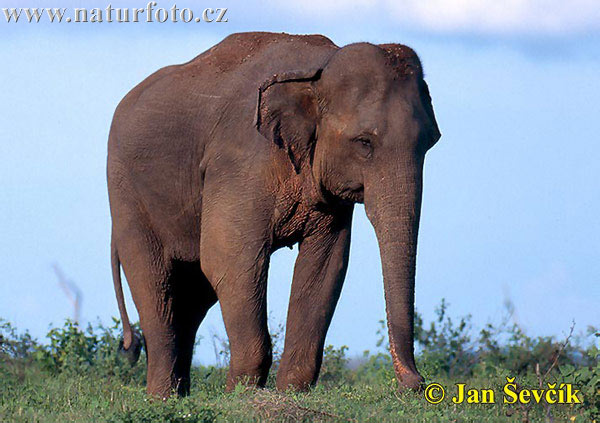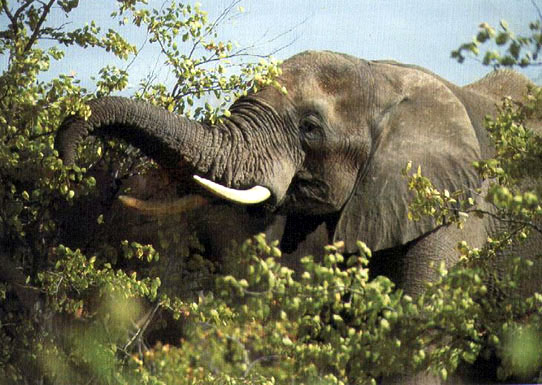These large herbivorous land mammals are also scientifically classified as Pychoderms meaning thick-skinned animals. There are two main living species of elephants; this includes the African elephant and the Asian elephant. These animals are fairly intelligent and are symbolized with wisdom in some Asian cultures.
Africa with a population of approximately 470 thousand to 690 thousand. Both female and male African elephants have large external tusks. There are two distinct sub-species of African elephants: the Savanna elephants and the Forest elephants. See the chart bellow for more information:
 The grey Asian elephants (also known as Indian elephants) are smaller and much hairier than their African cousins. Female Asian elephants are either tusk less or have a very small one, but the males have large external tusks (which are usually smaller than those of African elephants). The chart bellow names and specifies briefly the four sub-species of Asian elephants:
The grey Asian elephants (also known as Indian elephants) are smaller and much hairier than their African cousins. Female Asian elephants are either tusk less or have a very small one, but the males have large external tusks (which are usually smaller than those of African elephants). The chart bellow names and specifies briefly the four sub-species of Asian elephants:
1) African Elephant:
The brown-reddish African elephants are spread in 37 countries of African Elephant sub-species
No. | Sub-Specie | Habitat | Weight | Height (to shoulders) | |
1 | Savanna elephant | - Open grasslands, swamps, lake shores - South Saharan | - 3500-12000 kg | - up to 4 meters | |
2 | - Rainforests - Central and western | - up to 4500 kg | - up to 3 meters |
2) Asian Elephant:
 The grey Asian elephants (also known as Indian elephants) are smaller and much hairier than their African cousins. Female Asian elephants are either tusk less or have a very small one, but the males have large external tusks (which are usually smaller than those of African elephants). The chart bellow names and specifies briefly the four sub-species of Asian elephants:
The grey Asian elephants (also known as Indian elephants) are smaller and much hairier than their African cousins. Female Asian elephants are either tusk less or have a very small one, but the males have large external tusks (which are usually smaller than those of African elephants). The chart bellow names and specifies briefly the four sub-species of Asian elephants:Asian Elephants sub-species
No. | Sub-Specie | Habitat | Weight | Height (to shoulders) | ||
1 | Sri Lankan elephant | -Only | -Up to5400 kg | -Up to 3.4 meters | ||
2 | Indian elephant | -Mostly rainforests of most Asian countries ( | -Up to 5000 kg | -Up to 3.5 meters | ||
3 | Sumatran elephant | -Only in the -Forested and wooded environments | -Up to 3000 kg | -1.7-2.6 meters | ||
4 | - | - | - |
Notes:
* Borneo pygmy elephants have been identified in 2003 in Borneo so not much and exact information is valid.
Some of the Elephant's (both species) body parts are briefly explained bellow:
Trunk: (Proboscis)
The combination of the nose and the upper lip of an elephant is called the trunk. This appendage is very sensitive as it has over 40 thousand muscles and allows the elephant to pick up a single blade of grass. At the same time, it is strong enough to break branches.
Elephants suck water in using their trunk and then blow it into their mouth. They can use their trunk to spray water, mud and dirt onto their bodies which acts as a natural sunscreen.
These large mammals can use their trunk as a snorkel, for greeting each other by tangling their appendages (somewhat like a hand shake), for defending themselves and/or for smelling. Elephants are aided with an excellent sense of smell.
Tusk: (Ivory)
These continuously growing second upper incisors can grow up to 18 centimeters per year and can reach 3 meters in length and weigh up to 90 kilograms. Tusks are made up of Calcium phosphate which can be consumed through the food which the elephants eat. Tusks are mainly used for digging (for water, salt, roots etc.), clearing paths and/or as a weapon. The desire of humans for elephant tusks is one of the main factors in reduction of the elephant population.
Just like humans who are either left or right handed, elephants are either left or right tusked. Their main tusk is called the “master tusk” and tends to be shorter than the other one. Living species of elephants have a pair of tusks on their upper jaw; some extinct species had only a pair of tusks on their lower jaw or even on both lower and upper jaws.
Teeth:
Unlike many other mammals which grow baby teeth at first and then replace them with a permanent set of teeth, elephants have a cycle of tooth rotation throughout their life. This means that new teeth will appear in the back of the mouth. They will move forward horizontally and will push the older teeth towards the front of the mouth. The old teeth will wear down and eventually fall out of the mouth.
Old elephants mostly eat soft and wet grass to reduce the wearing down of teeth. When the last set of teeth fall, elephants will be unable to eat and will die of starvation.
Skin:
The skin of elephants is tough and also very sensitive. The skin around the mouth and in the ears is fairly thin but those of most other parts have approximately 2.5 centimeters of thickness. Elephants are often observed spurting mud on themselves; this acts as a natural sunscreen, decreases the loss of moisture, and also regulates the body temperature.
Ears:
Containing a rich network of blood vessels and a thin layer of skin, the elephant’s large flapping ears are very important especially in hot climates. On hot days, elephants are often seen flapping their ears. This constant moving of the ears creates a small breeze which cools the surface blood vessels. As the blood circulates around the body, it will drop the body temperature. This act can decrease the temperature of the body up to 10 degrees (Fahrenheit).
The size of the ears depends on the geographical distribution of elephants. Those which live in warmer regions, such as the African elephants, have larger ears than those who live in rather cooler conditions, such as the Asian elephants.
As well as playing an essential role in the regulation of the body temperature of elephants, the ears are used to intimidate predators by spreading their ears in order to look bigger. Elephants have very few predators such as lions and its kind.
Legs and Feet:
Elephants have straight and post like legs and nearly round, pad-like feet. As an elephant’s legs are straight, it uses a small amount of muscular power and can stand on its feet for a long time without getting tired.
Another slight difference between Asian and African elephants is in the number of nails they have on their front and back feet. While the Asian elephants have four nails on their front feet and three on their back feet, their African cousins have five nails on their front feet and four on their back feet.
Behavior , Intelligence & Senses:
Male elephants tend to live a solitary life whereas females live in tightly knitted family groups. Males separate from their families more and more as they grow up. They will start an independent life at the approximate age of 14 and might form a group with other male elephants, which is called a “bachelor herd”. Females on the other hand, tend to live with their daughter/s, sister/s, mother, aunt/s etc.
An elephant’s brain, weighing at approximately five kilograms, is larger than that of any other land animal. The hearing, smelling, movement co-ordination, trunk management and sensitivity sections of an elephants brain cover the most area. This shows that an elephant acts greatly in these cases. The intelligence of these animals is also used in circuses.
Elephants have hearing receptors in their ear, on their trunk which are very sensitive to vibrations and also on their feet. These thick-skinned mammals can communicate over large distances (kilometers) by producing a low frequency sound which travels on the ground (and can travel farther than sound in air). This sound will be received by the sensitive hearing receptors on the feet and the trunk.
Diet:
Elephants eat a large variety of herbivorous foods such as leaves, bamboo, roots, bark, fruit, seeds, flowers etc. Less than half of the large amount of food they eat is digested and the rest comes out undigested.
Reproduction:
Female elephants reach maturity at the approximate age of 13 and tend to choose a stronger, bigger and older male in order for the calf to have more chance of survival. After the gestation period (pregnancy period), which is approximately 22 month, the calf is born blind and depends on its trunk as to search its surrounding. Calves are usually 70 to 80 centimeters tall and weigh about 113 kilograms.







No comments:
Post a Comment